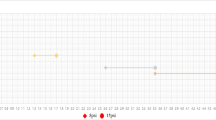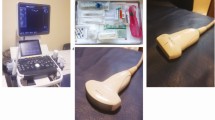Abstract
Intraosseous cannulation is an accepted means to achieve vascular access when peripheral venous access is not available. It is common practice to flush the intraosseous cannula with saline prior to establishing infusions. The objective of this study was to evaluate changes in intraosseous pressure during the flush procedure and to assess the variability of pressure changes induced by different practitioners. Two intraosseous cannulas were placed in an isolated cadaveric femur collected from a swine. Intraosseous pressure and the rate of change in pressure were recorded continuously during a series of saline flushes into a distal femoral intraosseous cannula by 21 members of the veterinary research staff at the authors' institution. Median peak intraosseous pressures exceeded 600 mmHg, and an inverse relationship was noted between peak intraosseous pressure and the duration of flush. Bone marrow fat emboli were grossly evident in flush effluents and their presence was confirmed by microscopic examination. Until the practitioners were informed of the pressure changes induced by the intraosseous cannula flush, few had appreciated the magnitude of the pressures that they had generated, suggesting that an instrumented intraosseous flush preparation like the one used in this study may prove useful as a training tool for flush procedures.
This is a preview of subscription content, access via your institution
Access options
Subscribe to this journal
We are sorry, but there is no personal subscription option available for your country.
Buy this article
- Purchase on Springer Link
- Instant access to full article PDF
Prices may be subject to local taxes which are calculated during checkout






Similar content being viewed by others

References
Eslami, P. Pediatric intraosseous access. Medscape Reference <http://emedicine.medscape.com/article/940993-overview> (2011).
Hughes, D. & Beal, M.W. Emergency vascular access. Vet. Clin. North Am. Small Anim. Pract. 30, 491–507 (2000).
Otto, C.M., Kaufman, G.M. & Crowe, D.T. Intraosseous infusion of fluids and therapeutics. Comp. Cont. Educ. Pract. Vet. 11, 421–431 (1989).
Jackson, E.E. et al. Performance and longevity of a novel intraosseous device in a goat (Capra hircus) model. J. Am. Assoc. Lab. Anim. Sci. 50, 365–373 (2011).
Zehnder, A. Intraosseous catheter placement in small mammals. Lab Anim. (NY) 37, 351–352 (2008).
Valverde, A., Bienzle, D., Smith, D.A., Dyson, D.H. & Valliant, A.E. Intraosseous cannulation and drug administration for induction of anesthesia in chickens. Vet. Surg. 22, 240–244 (1993).
Morrisey, J.K. Aspects of avian emergency medicine I. 82nd Annual Western Veterinary Conference, Las Vegas, NV. 14–18 February 2009.
Miller, L., Kramer, G.C. & Bolleter, S. Rescue access made easy. JEMS 30, 8–19 (2005).
Bukoski, A., Winter, M., Bandt, C., Wilson, M. & Shih, A. Comparison of three intraosseous access techniques in cats. J. Vet. Emerg. Crit. Care (San Antonio) 20, 393–397 (2010).
Orlowski, J.P., Porembka, D.T., Gallagher, J.M., Lockrem, J.D. & VanLente, F. Comparison study of intraosseous, central intravenous, and peripheral intravenous infusions of emergency drugs. Am. J. Dis. Child 144, 112–117 (1990).
Ngo, A.S., Oh, J.J., Chen, Y., Yong, D. & Ong, M.E. Intraosseous vascular access in adults using the EZ-IO in an emergency department. Int. J. Emerg. Med. 2, 155–160 (2009).
Philbeck, T.E., Miller, L.J., Montez, D. & Puga, T. Hurts so good. Easing IO pain and pressure. JEMS 35, 58–62 (2010).
The Consortium on Intraosseous Vascular Access in Healthcare Practice. Recommendations for the use of intraosseous vascular access for emergent and nonemergent situations in various health care settings: a consensus paper. Crit. Care Nurse 30, e1–e7 (2010).
Gluckman, W. Intraosseous cannulation. Medscape Reference <http://emedicine.medscape.com/article/908610-overview> (2008).
Voigt, J., Waltzman, M. & Lottenberg, L. Intraosseous vascular access for in-hospital emergency use: a systematic clinical review of the literature and analysis. Pediatr. Emerg. Care 28, 185–199 (2012).
Wayne, M.A. Adult intraosseous access: an idea whose time has come. Israeli J. Emerg. Med. 6, 41–45 (2006).
Davidoff, J. et al. Clinical evaluation of a novel intraosseous device for adults: prospective, 250-patient, multi-center trial. JEMS 30, 20–23 (2005).
Peltier, L.F. The mechanics of parenchymatous embolism. Surg. Gynecol. Obstet. 100, 612–618 (1955).
Fong, D.L., Murnane, R.D., Hotchkiss, C.E., Green, D.J. & Hukkanen, R.R. Pulmonary embolization of fat and bone marrow in cynomolgus macaques (Macaca fascicularis). Comp. Med. 61, 86–91 (2011).
Akhtar, S. Fat embolism. Anesthesiol. Clin. 27, 533–550 (2009).
Rubal, B.J., Muderhwa, J.M. & Rushing, S.R. Assessment of iatrogenic fat embolism with Nile red. FASEB J. 26, lb43 (2012).
Institute for Laboratory Animal Research. Guide for the Care and Use of Laboratory Animals 8th edn. (National Academies Press, Washington, DC, 2011).
Warren, D.W., Kissoon, N., Sommerauer, J.F. & Rieder, M.J. Comparison of fluid infusion rates among peripheral intravenous and humerus, femur, malleolus, and tibial intraosseous sites in normovolemic and hypovolemic piglets. Ann. Emerg. Med. 22, 183–186 (1993).
Tan, B.K., Chong, S., Koh, Z.X. & Ong, M.E. EZ-IO in the ED: an observational, prospective study comparing flow rates with proximal and distal tibia intraosseous access in adults. Am. J. Emerg. Med. published online, 10/1016/j.ajem.2011.10.025 (11 January 2012).
Cilley, R.E. Intraosseous infusion in infants and children. Semin. Pediatr. Surg. 1, 202–207 (1992).
Tobias, J.D. & Ross, A.K. Intraosseous infusions: a review for the anesthesiologist with a focus on pediatric use. Anesth. Analg. 110, 391–401 (2010).
Orlowski, J.P., Julius, C.J., Petras, R.E., Porembka, D.T. & Gallagher, J.M. The safety of intraosseous infusions: risks of fat and bone marrow emboli to the lungs. Ann. Emerg. Med. 18, 1062–1067 (1989).
Johnson, D.L., Findlay, J., Macnab, A.J. & Susak, L. Cadaver testing to validate design criteria of an adult intraosseous infusion system. Mil. Med. 170, 251–257 (2005).
Rubal, B.J., Gerhardt, R.T., Sartin, C.W., Neal, C.L. & DeLorenzo, RA. Medullary shear and pressure changes associated with high intraosseous infusion rates in an isolated hind limb preparation. Ann. Emerg. Med. 56, S113 (2010).
Mellor, A. & Soni, N. Fat embolism. Anaesthesia 56, 145–154 (2001).
Pfeifer, R., Sellei, R. & Pape, H.C. The biology of intramedullary reaming. Injury 41 (suppl. 2), S4–S8 (2010).
Shaikh, N. Emergency management of fat embolism syndrome. J. Emerg. Trauma Shock 2, 29–33 (2009).
Fiallos, M. et al. Fat embolism with the use of intraosseous infusion during cardiopulmonary resuscitation. Am. J. Med. Sci. 314, 73–79 (1997).
Hasan, M.Y. et al. Intraosseous infusion and pulmonary fat embolism. Pediatr. Crit. Care Med. 2, 133–138 (2001).
Orlowski, J.P. My kingdom for an intravenous line. Am. J. Dis. Child. 138, 803 (1984).
Byrick, R.J. Pulmonary fat embolism and intraosseous infusion. Pediatr. Crit. Care Med. 2, 184–185 (2001).
Acknowledgements
We thank the veterinarians, veterinary technicians and senior research staff at the US Army Institute of Surgical Research for their participation and support of this project. Funding for this project was in part provided by Advanced Medical Technology Initiative (AAMTI-1574). The content of this manuscript was presented at the 62nd AALAS National Meeting (2011) in San Diego, CA. The views expressed in this commentary are those of the authors and do not reflect the official policy or position of the Department of the Army, Department of Defense, or the US Government.
Author information
Authors and Affiliations
Corresponding author
Ethics declarations
Competing interests
The authors declare no competing financial interests.
Rights and permissions
About this article
Cite this article
Rubal, B., McKay, K., Armstrong, K. et al. Variability in intraosseous pressure induced by saline flush of an intraosseous cannula by multiple practitioners. Lab Anim 41, 224–229 (2012). https://doi.org/10.1038/laban0812-224
Received:
Accepted:
Published:
Issue Date:
DOI: https://doi.org/10.1038/laban0812-224


